Intel Yonah Performance Preview - Part I: The Exclusive First Look at Yonah
by Anand Lal Shimpi on November 30, 2005 2:50 AM EST- Posted in
- CPUs
Same Size, but Twice the Cores
Obviously the biggest improvement Yonah offers over Dothan is the fact that it’s dual core. But where things get interesting is that thanks to Yonah’s 65nm process, a dual core Yonah die is about the same size as a single core Dothan die - in other words, it costs Intel just as much to make a dual core Yonah, as it did for them to make a single core Dothan.
A major reason the die size didn’t really go up much is because although Yonah has two cores, its L2 cache size remains unchanged at 2MB. Unlike the Pentium D, Yonah’s 2MB L2 cache is not split into two discrete 1MB caches, it is actually one whole 2MB cache that is shared by both cores. This is a very important distinction, as it means that Yonah is far from just two Dothans stuck together.
There are other architectural enhancements to Yonah that will give it a performance advantage over Dothan. Below is an excerpt from our IDF coverage of Yonah, detailing what we know about the new CPU:
Making Pentium M more "Media Friendly"
All of the major performance improvements to each of Yonah's cores seem to revolve around SIMD FP and FP performance, two of the Pentium M's present day weaknesses in comparison to the Pentium 4.
The first improvement is that now all three of Yonah's decoders can decode SSE instructions, regardless of the type of instruction. Improving the decode width of the processor is a quick way to improve performance.
Next, SSE/SSE2 operations (not sure if all can be, but at least some) can now be fused using the Micro Ops Fusion engine of Yonah. At a high level, the benefit here is increased performance and lower power consumption, we'll get into architectural details of why that is when we eventually sink our teeth into Yonah next year.
Each of the two cores in Yonah have also received support for SSE3 instructions much like the Pentium 4 E [Prescott].
And finally there have been some improvements to Yonah's floating point performance, although Mooly would not say exactly what's been done. Curiously, Mooly referred to the floating point performance improvements as specifically made to improve gaming performance. Intel may have grander plans for Yonah than once thought...
The SSE/FP optimizations are all being grouped into what Intel is calling their Digital Media Boost technology, yes the names seem to get worse and worse as time goes on - but at least the functionality should be good.
We started out this article talking about the Pentium M’s shortcomings in digital media applications, and Intel has begun to address them with the architecture of Yonah, but the real question is - how effective have their efforts been?











135 Comments
View All Comments
fitten - Wednesday, November 30, 2005 - link
I've wanted an AMD 64-bit laptop for a while so that was a good read and made me feel a bit better about Turions.One other interesting thing about Yonah is the power management capabilities. I'd be interested to see the upcoming dual core Turion specs there. For instance, the Yonah, when in battery conservation mode, can turn off a complete core and parts of the L2 cache. I can't imagine the dual core Turion not having similar things, though, it would really give Intel the edge.
tayhimself - Wednesday, November 30, 2005 - link
UGH! I meant dual core Turion laptops in the last linebhtooefr - Wednesday, November 30, 2005 - link
Umm...Note that it said "Total System Power Consumption" in the graphs...
Viditor - Wednesday, November 30, 2005 - link
Yup...my bad. (sorry for that Anand...)I really would like to get more info on the tests though. I understand that they have to keep the origins of the mobo quiet, but without the details it makes it very difficult to gauge exactly what and how the tests were conducted...
I would also LOVE an "edit" function on these things...:)
Calin - Friday, December 2, 2005 - link
How about the overclocking experience?